The Amateur Astronomy Association (AAA) opened its 32nd Astrophotography Exhibition, the Summit of the Stars, from October 27-29. The AAA is a group of passionate star watchers oozing with love for clusters of stars to lonely celestial bodies. The Summit of the Stars provides a spectacular new visualization of our galaxy endeavoring to popularize stars at SNU.
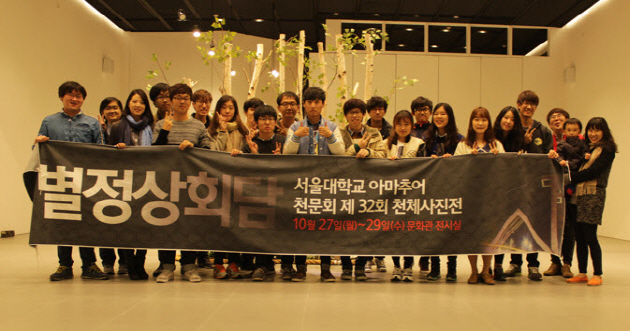
AAA members
The Amateur Astronomy Association
Club activities include gazing at stars through telescopes and taking photographs of the celestial bodies. While the KIM Tae Young Dome at SNU serves as the main observatory, members go on regular trips to Kangwondo, known for its unpolluted night skies overflowing with stars.
Diverse people from different studies constitute the membership of AAA. Each semester, more than 100 people apply to the AAA. According to the AAA’s President, KIM Yoon Sik (Dept. of Physics and Astronomy), around 35% of the members are from the college of social sciences, humanities, or art. Yoon Sik hopes that the AAA could be a hearth that embraces the diversity of all members.

People at the exhibition
An Invitation to the Romantic Exhibition
The exhibition was composed of several parts based on astrophotography types. Once you enter building 73, the University Cultural Center, a member of AAA walks you through the romance of the night skies.
Scenic Astrophotography
Scenic astrophotography works include both the landscape and celestial bodies in one frame. These photos give viewers the feeling that they are present at that location, looking at the landscape with bare eyes. Scenic photos are taken on a fixed camera with short-exposure time to capture stars in the shape of dots. Because of the simple and easy technique, anybody could take on the challenge to produce a scenic night sky photo populated with stars.
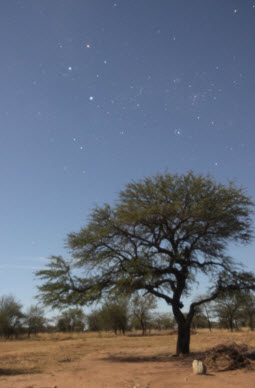
The Bohemian’s Full Moon (JANG Han Kyul) - Taken in Tanzania’s Serengeti National Park, the picture depicts the Crux constellation. The Crux cannot be observed in the sky in Korea.

Hawaii’s Milky Way (KIM Yoo Jung) - Captured in a downward view from the top of the 3000m Halekalā Mt. on the island of Maui, the harmony of the cirrus cloud and milky way form a picturesque scene. Cirrus clouds indicate deteriorating weather and appear as tufts and thin wisps of cloud strands.
The Solar System
Photographs of the solar system unveil the multifarious images of the sun, moon, and other celestial bodies that we habitually see, but scarcely notice. Having newly participated in the AAA last semester, OH Eun Sil (Dept. of Earth and Environmental Science) learned to appreciate the omnipresence of stars in the night sky.
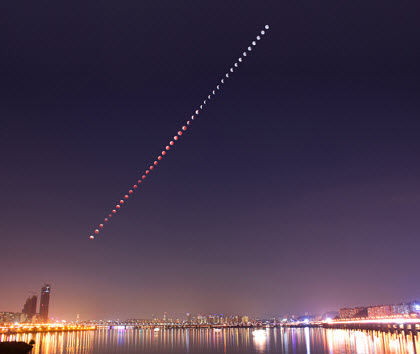
Red Moon White Moon (SEO Yu Kyung) - This photo shows the lunar eclipse of the moon viewed from the Hangang River Bridge, composed of 42 pictures taken every 4 minutes.
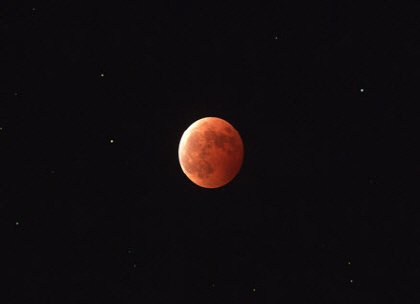
Sweet Moon-like You (OH Eun Sil) - This is a total eclipse of the moon captured from the KIM Observatory at SNU.
“The photo of the eclipsed moon (Sweet Moon-like You) is the first astrophotograph I have ever taken. In the beginning, observing through the telescope was simply for fun, but I became more involved when I felt that the star I found and captured through the camera lens seemed like my own. It was like creating a work of art.”
She elaborated on the special attraction of the star observation activities. “I came to realize that astrological activities are similar to growing plants. Stars and celestial bodies are always around us. However, depending on one’s interest, he or she might not see anything or see more than the visible night sky. Most of the times, one carelessly passes under the sky, but once you learn about astrology, you can see so much more and feel an infinite admiration for the unknown universe.”
Currently taking on the role as the educator of the new members, Eun Sil emphasized that anyone interested in stars could learn to take astrophotography. The club’s room called the “Star Room” is open to everyone.
Star-Trail Tracing
Stars do not actually move. However, the earth’s rotation makes it seem as if the stars are moving. The camera’s slow shutter speed with long exposure time helps portray star-trails. Longer exposure time results in longer streaks, which are the trails of individual stars.

Flowing Poetry (AHN Soo Yeon) - Taken in Gwacheon, the photo (synthesis of 230 shots, 15 second gaps) shows common concentric circular star streaks, representative of the northern hemisphere.
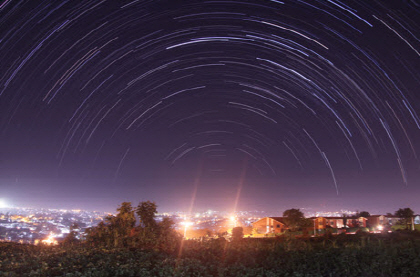
Shining (JANG Han Kyul) - A star-trail from Kigali, Rwanda demonstrates half-circular streaks since Rwanda is near the equator.
Piggyback Photography
Opposite to the star-trail technique, the piggyback method follows the movement of stars by utilizing a camera or lens mounted on a telescope. Through long exposure time, more nebulas and stars could be caught than seen with eyes.
KIM Dong Kyum (Dept. of Physics and Astronomy) is one of the skilled photographers who developed his talent through participation in the AAA. Yonhap News once featured his picture of the Horsehead Nebula in the news article on the year of the horse. Out of the many photos displayed at the Summit of the Stars, he chose the “Rising Milky Way of Gwanak Mt.” as his personal favorite.

Horsehead Nebula (KIM Dong Kyum) - The Horsehead Nebula, Dark Nebula, Alnitak, and Flame Nebula photographed at Supiryong, Kangwondo and featured in Yonhap News.

Rising Milky Way of Gwanak Mt. (KIM Dong Kyum) – This photo brings to reality the stunning Milky Way at SNU.
“Honestly, I was dubious that I could take a photo of the Milky Way in Seoul. Most people believed that it would not be possible. I had to try three times, before I could produce a satisfactory picture. Hard work proved that just because one cannot easily visualize the Milky Way in the Seoul sky does not mean that it do not exist.”
Deep Sky Photography
Deep sky photography employs equatorial mounts and a telescope to photograph the milky ways, nebulas, and star clusters beyond the solar system. The technique is difficult to master, but very rewarding.
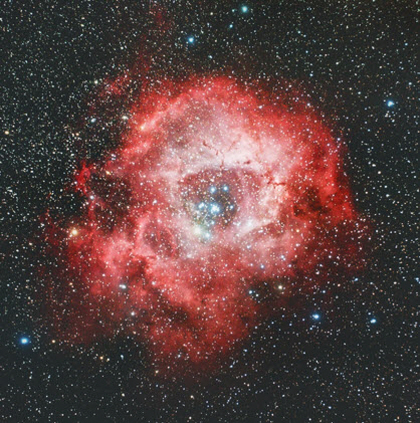
One Winter Night’s Rose (KIM Dong Kyum) – This is a winter Milky Way near the left of the Orion constellation in the sky of Kangwondo’s Baekma Highlands.

The Pillars of Creation (KIM Dong Kyum) - Featuring the Eagle Nebula and its Pillars of Creation that contain large regions of star formation, Dong Kyum captured the photo through an online remote controlled telescope at the Siding Spring Observatory in Australia.
SNU 24 hour Time-Lapse Project
For every exhibition, the new members of AAA create an ingenious project. This semester, the new members captured 24 hours of SNU at different places frequented by the students. The Time-Lapse Project reflects upon the busy lives of SNU students heading towards a specific destination and purpose delivering the message that sometimes we should slow down.
The following map provides the names of the locations, the time, and the number of time-lapse photos taken. To see the full video: http://www.youtube.com/watch?v=zWiLpjMtMKw
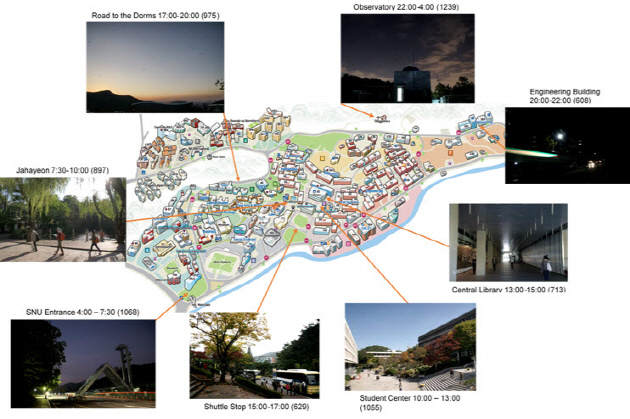
Exhibition places on campus
The Summit of the Stars tells us that taking notice of the small things in life awakens you to an undiscovered world, forgotten among the hectic daily activities. But stars can be a source of consolation and wisdom. As Roman philosopher Lucan said, “Amid the storms of war, with curious eyes, I trace the planets and survey the stars,”
Written by BAE Su Hyen, SNU English Editor, suhyenbae@snu.ac.kr
Reviewed by Eli Park Sorensen, SNU Professor of Liberal Studies, eps7257@snu.ac.kr

